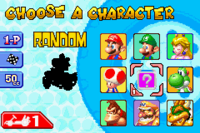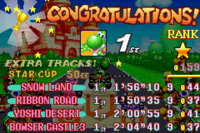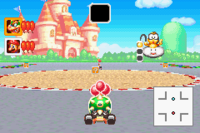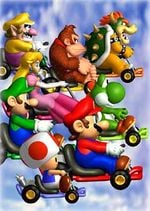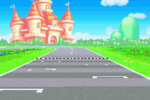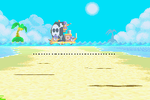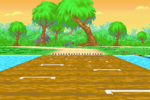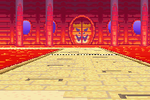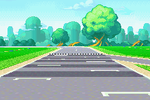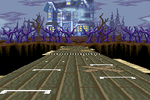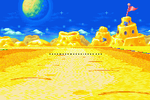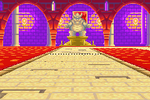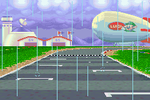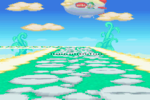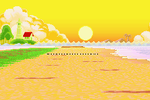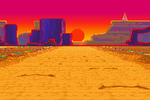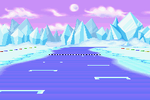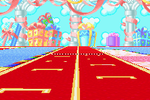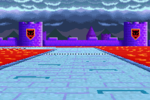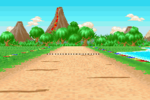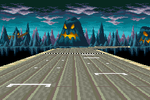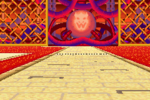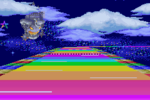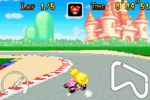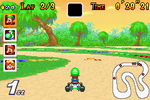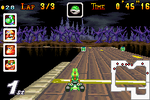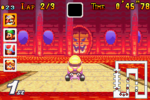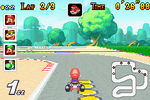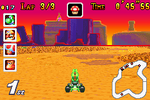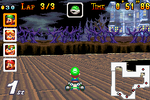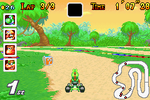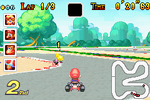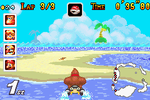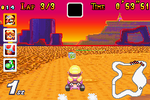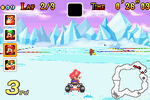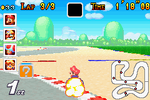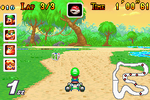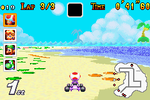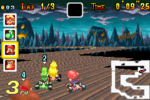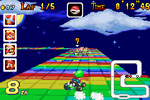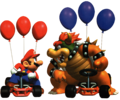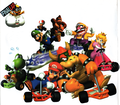Mario Kart: Super Circuit
- "Mario Kart Advance" redirects here. For the playing cards, see Mario Kart Advance (playing cards).
| Mario Kart: Super Circuit | |||||||||||||||
|---|---|---|---|---|---|---|---|---|---|---|---|---|---|---|---|
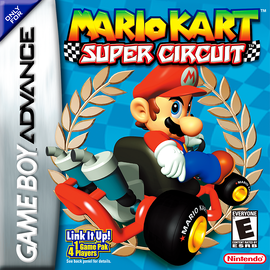 For alternate box art, see the related gallery. | |||||||||||||||
| Developer | Intelligent Systems | ||||||||||||||
| Publisher | Nintendo | ||||||||||||||
| Platforms | Game Boy Advance, Virtual Console (Nintendo 3DS, Wii U), Game Boy Advance - Nintendo Classics | ||||||||||||||
| Release dates | Game Boy Advance: Player's Choice: Virtual Console (3DS) (Ambassador Program): Virtual Console (Wii U): Game Boy Advance - Nintendo Classics: | ||||||||||||||
| Languages | English Japanese | ||||||||||||||
| Genre | Racing | ||||||||||||||
| Ratings |
| ||||||||||||||
| Modes | Single-player, multiplayer | ||||||||||||||
| Format | Wii U: Nintendo Switch: Game Boy Advance: Nintendo 3DS: | ||||||||||||||
| Input | Wii U: Nintendo Switch: Game Boy Advance: Nintendo 3DS:
| ||||||||||||||
| Serial codes | |||||||||||||||
Mario Kart: Super Circuit is a racing game for the Game Boy Advance, published by Nintendo and developed by Intelligent Systems. It is the third entry in the Mario Kart series and the first one to be released for a handheld, as well as the second Super Mario franchise game and third overall Nintendo-published game released for the system. The game was released in 2001, on July 21 in Japan, August 27 in North America, and September 7 and 14 in Australia and Europe respectively. Mario Kart: Super Circuit combines the elements from its Super NES and Nintendo 64 predecessors, with the key feature of the Mario Kart series being the usage of items obtained from Item Boxes in order for the operator to gain an advantage over the opponents being retained; additionally, it contains all the courses from Super Mario Kart. Mario Kart: Super Circuit allows up to four players to play the game through the Game Link Cable, including a more restricted multiplayer mode that only requires one Game Pak.
Mario Kart: Super Circuit was eventually re-released on the Nintendo 3DS's Virtual Console exclusively through the Nintendo 3DS Ambassador Program first in Oceania on December 15, 2011, then in other countries on December 16, 2011. The game was re-released again on the Wii U's Virtual Console in North America first on November 13, 2014, and for Game Boy Advance - Nintendo Classics as one of its launch titles on February 8, 2023. Mario Kart: Super Circuit is the first Mario Kart title to have its development outsourced to another company, as well as the last Mario Kart game where the drivers are sprites rather than models. It is also one of the last entries in the Super Mario franchise to use the Nintendo 64-era art direction (which had been in place since Super Mario 64 in 1996), as Nintendo started to update the 3D art direction after 2001, starting with Luigi's Mansion.
Gameplay[edit]
The objective in this game is to place first in the races, as with most racing games. Each race has eight drivers. As in other Mario Kart games, players can drive through Item Boxes which contain items, which can aid the players. On the course, coins are collected to increase the kart's top speed. Like with Super Mario Kart, if the player has no coins, they spin out if they collide with another racer. The player starts a race with 2 to 5 coins depending on the starting position, and 50 coins are found on each course. Therefore, the player can hold up to 55 coins at once.
This game has five cups, and each has four new race courses. These cups are the Mushroom Cup, the Flower Cup, the all new Lightning Cup (referred to as the Thunder Cup in manuals), the Star Cup, and the Special Cup. If players collect 100 coins in each cups after winning Special Cup for the engine class, they unlock the Extra Cup version. These cups contain all of the courses from Super Mario Kart. If the player manages to collect a gold trophy on all of the Super Circuit cups, the background for the title screen changes to a sunset. If the player manages to obtain a triple star ranking for all Super Circuit cups, the title screen's background changes to a night time setting. In addition to the aesthetic changes, the intro's theme also changes.
Controls[edit]
The controls can be customized on Wii U Virtual Console.
Menu controls[edit]
| Action(s) | Game Boy Advance | Nintendo 3DS | Wii U GamePad Wii U Pro Controller Wii Classic Controller |
Wii Remote | Dual Joy-Con Nintendo Switch Pro Controller |
Single Joy-Con |
|---|---|---|---|---|---|---|
| Select | ||||||
| Confirm | ||||||
| Cancel | ||||||
| Access options for certain modes |
Game controls[edit]
| Action(s) | Game Boy Advance | Nintendo 3DS | Wii U GamePad Wii U Pro Controller Wii Classic Controller |
Wii Remote | Dual Joy-Con Nintendo Switch Pro Controller |
Single Joy-Con |
|---|---|---|---|---|---|---|
| Steer left or right | ||||||
| Accelerate / Rocket Start (Start of race) | ||||||
| Brake | ||||||
| Hop and Power Slide | ||||||
| Use Items, stop Item Roulette | ||||||
| Go in reverse | ||||||
| Shoot Item in certain direction | ||||||
| Quick sharp turn left or right | ||||||
| Pause game | ||||||
| Horn |
- On the character selection screen, if the player presses the
 button, the character the player is on fires a green shell. If the player presses the
button, the character the player is on fires a green shell. If the player presses the  button, the character hops. If the player presses the
button, the character hops. If the player presses the button, the characters honk their horn. However, the horn does not work if Random is selected.
Game modes[edit]
Mario Kart: Super Circuit has five different game modes: Grand Prix, Time Trial, Quick Run, VS, and Battle Mode. All are accessed by the single player except VS and battle modes. Up to four players can participate using the Game Boy Advance Link cable with even a single game cartridge. However, all players using single cartridge mode are limited to selecting Extra Mushroom Cup using only Yoshi and different colors of him.
Grand Prix[edit]
In this mode, one or two players race against the CPU. The player chooses a cup and plays the four courses it contains. The player earns points by placing within the first four positions. When finished in fifth place or lower, the player must restart the race. The player is able to restart a race three times, with three race flags representing the lives. When the flags run out, the player can no longer restart any race in the cup, and must start from the first race if they fail to reach 4th or higher. When playing with two players, only one player has to finish in the top four in order to move on to the next race. At the end of the cup, the player with the most points wins. If the player is ranked 4th or lower at the end of a Grand Prix, their character drives in front of the three winning drivers and gets crushed by the podium. There are three different speeds to choose from, each with varying difficulty.
- 50cc - This engine size is the smallest engine size. Karts go at a slower pace than other engine sizes. Computers rarely use items against the player. This engine size is best suited for beginners.
- 100cc - A slightly larger engine size. Karts go slightly faster than 50cc, but not as fast as 150cc. Computers use items more often against the player. This engine size is better suited for intermediate players.
- 150cc - The largest engine size. Karts go at their fastest. The computer regularly uses items against the player, such as frequently throwing Red Shells, using Boos, or even tossing a Spiny Shell. This engine size is best suited for expert players.
Ranking[edit]
At the end of each race in Grand Prix mode, the top four players are awarded points based on their placement. The player in first place receives nine points, second place receives six points, third place three points, and fourth place one point. The bottom four players do not receive points.
The following letter ranks are achievable solely based on how many points the player has at the end of the four races of a Grand Prix:
- A: The player has collected all 36 points.
- B: The player has collected at least 30 points.
- C: The player has collected at least 25 points.
- D: The player has collected at least 20 points.
- E: The player has collected less than 20 points.
However, during each race, the game also secretly tracks several statistics to calculate a hidden value known internally as SkillPoints. These statistics all contribute in different ways to the final SkillPoints calculation at the end of each race.[7] Note that an unmodified copy of Mario Kart: Super Circuit runs at 60 frames per second.
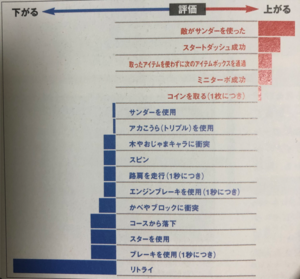
| Variable | Description | Impact on SkillPoints |
|---|---|---|
| FramesOutsideTrack | How many animation frames the character spends on off-road sections of the track. Some courses are marked as containing no off-road sections, such as the Bowser Castle courses and, strangely, Mario Circuit 2 and Choco Island 2. These courses instead increment this value each time a character hits a wall. (In Choco Island 2, the mud pool in the middle of the course still counts as an off-road section.) | Each frame the character spends on off-road sections of the track decreases SkillPoints by 0.25. |
| FramesNotHittingGas | How many frames the player does not hold down the accelerate button for. | Each frame the player does not hold down the accelerate button for decreases SkillPoints by 0.25. |
| FramesHittingBrakes | How many frames the player holds down the brake button for. | Each frame the player holds down the brake button for decreases SkillPoints by 2. |
| Item3RedShellsUseCount | How many times the player uses the Triple Red Shells item. | Each time the player uses Triple Red Shells decreases SkillPoints by 5. |
| ItemLightningUseCount | How many times the player uses the Lightning item. | Each time the player uses Lightning decreases SkillPoints by 5. |
| ItemStarUseCount | How many times the player uses the Star item. | Each time the player uses a Star decreases SkillPoints by 30. |
| EntityHitCount | How many times the character hits another driver or enemy. | Each time the character hits another driver or enemy decreases SkillPoints by 15. |
| GotHitAndSpunCount | How many times the character spins out and loses coins, whether from an item or enemy. | Each time the character spins out decreases SkillPoints by 15. |
| WallHitCount | How many times the character bumps into a wall. | Each time the character bumps into a wall decreases SkillPoints by 20. |
| StartMiniturboCount | How many times the character performs a Rocket Start, or boosts upon hitting the ground after being picked up by Lakitu. | Each time the character performs a Rocket Start or boosts after Lakitu picks them up increases SkillPoints by 25. |
| LakituRescueCount | How many times Lakitu places the character back on the track. | Each time the player is rescued by Lakitu decreases SkillPoints by 30. |
| RemainingLifes | How many times the player has restarted the race. | Each time the player restarts the race decreases SkillPoints by 120. |
| Coins | The number of coins collected during the race. | Each coin the character has at the end of the race increases SkillPoints by 4 per coin. |
| ItemBoxWhileFullHitCount | How many times the character passes through an Item Box while an item already occupies the item slot. Holding an item behind the character, or having Triple Green Shells or Triple Red Shells circle the character, does not count as an item occupying the item slot. | Each time the character passes through an Item Box while an item already occupies the item slot increases SkillPoints by 15. |
| LightningHits | The number of times a character is hit by the Lightning item. | Each time the character is hit by Lightning increases SkillPoints by 40. |
| LapTime | The amount of time the player takes to complete each lap. | The player must beat a unique time for each course to receive extra SkillPoints based on how much faster than the target time the course completion time is. This target time is often very low. |
| ccWeight | The engine class (cc) selected. |
|
| CharacterEndRaceValue | Which character the player selects to play as. This value is seemingly connected to how difficult the character is to use in a race based on their stats. |
|
| TrackValue | A unique value that varies for each course in the game. | Completing a certain course awards SkillPoints equal to that course's TrackValue. |
Although race placement does impact SkillPoints, there is no direct relationship. Instead, the player's placement for each race is measured relative to the position the best-placed CPU opponent ends the race with. The calculation that provides this value is known as PositionPoints. The below table shows the number of PositionPoints added to SkillPoints depending on the player's and CPU's placement points.
| Player's race placement relative to CPU's placement | 1st | 2nd | 3rd | 4th |
|---|---|---|---|---|
| The difference between the player's and CPU's placement points is 2 or less | 20 | 10 | 0 | 0 |
| The difference between the player's and CPU's placement points is between 3 and 8 | 40 | 20 | 10 | 0 |
| The difference between the player's and CPU's placement points is more than 8 | 60 | 30 | 20 | 10 |
The game calculates the average of the four SkillPoints values across each race to generate a final SkillLevel value. If the player has obtained all 36 standard points from race placement, all three star ranks are obtainable, depending on the SkillLevel value:
- ⭐⭐⭐: SkillLevel > 329
- ⭐⭐: SkillLevel > 199
- ⭐: SkillLevel > 99
- A: SkillLevel > 29
If the player has obtained at least 27 points, the following ranks are possible:
- ⭐⭐: SkillLevel > 329
- ⭐: SkillLevel > 199
- A: SkillLevel > 99
If the player has obtained at least 21 points, the ⭐ rank is possible if SkillLevel > 329.
Time Trial[edit]
One player can race against the best times on each course with no CPU opponents. After beating a best time, players can save Ghost data onto each time trial course. Whenever the player races on that course again, the player's Ghost mirrors movements of the saved data. Ghost data can also be downloaded from other players using the Game Boy Link Cable. Players are given Triple Mushrooms for use during Time Trials. Players also have the option to view their Ghost data using the Records option. Players can either turn their Ghost on or off during Time Trials using the before selecting the mode.
Quick Run[edit]
Quick Run is a one player VS mode, unique to Mario Kart: Super Circuit, that enables players to race on any tracks they unlocked with no restrictions or regulations. Players can choose what engine size they want to race on, with the difficulty level alongside with the speed. Players can alter the number of laps, appearance of coins, and Item Boxes by pressing before accessing this mode. Later Mario Kart installments since Mario Kart DS (excluding Mario Kart 7) allow VS mode to be played with one player.
VS[edit]
VS mode is a Quick Run mode with two to four players and cannot be accessed by single players. Players can play with multiple game cartridges (Multi-Pak mode) or just a single cartridge (Single-Pak mode) via Game Boy Link Cable. CPU racers are turned off in this mode, and players start with 10 coins. The game counts how many times the player won or lost against other players. Players can alter the number of laps, appearance of coins, having Triple Mushrooms as starting items and Item Boxes by pressing before accessing this mode, but only if it is played in Multi-Pak mode. In Single-Pak mode, players have more limited choices. Players use a different colored Yoshi where player 1 is Green, player 2 Red, player 3 Light Blue, and player 4 Yellow. Additionally, the only courses available are four SNES courses: Mario Circuit 1, Donut Plains 1, Ghost Valley 1, and Bowser Castle 1. The character and item animations and music quality are also simplified compared to the base game to ease the amount of data that has to be transferred, and the music itself consists of arrangements of Super Mario Kart music: the course selection menu music is an arrangement of the menu music, the racing music is an arrangement of the title theme, and the result screen music is an arrangement of Mario's results theme. In both multiplayer modes, after all other racers finish a race, Lakitu drops a Thwomp on the racer in last place, ending the race.
Battle[edit]
Just like VS mode, Battle mode cannot be played with only one player. The player participates with one to three other players in attempt to pop each other balloons using items. Also seen in VS mode, the game counts how many times the players won or lost. When a player loses all of their balloons, the player turns into a Bob-omb and stays like that for the rest of the game. The Bob-omb can make it more difficult for the other players by either picking up Item Boxes or blasting into their karts.
Characters[edit]
All playable characters from Mario Kart 64 return, along with colored Yoshis appearing only in the multiplayer mode. As in all the previous games, they also race in the same go-karts, but with different sizes and colors that suit each playable character. Also, as in all the previous games, each racer is classified into three categories: lightweight, middleweight, and heavyweight, each class with their own advantages and disadvantages. Additionally, in VS play with a single cartridge, all players use Yoshi, with each being a different color.
The Japanese version's stats are translated as acceleration and weight, the international release displays the acceleration stat as "speed", though the instruction booklet describes more accurate stats.
Lightweights are generally characterized by having high acceleration and low top speed. They are knocked easier by heavyweights and middleweights and skid easier. Peach and Toad share the same stats as having the highest acceleration and the least weight in the game, and Yoshi offers slightly less acceleration for slightly better weight, although his speed is lower and his handling is higher.
Middleweights are classified by their mostly all-around stats, not having any significantly low stats. The only middleweights are Mario and Luigi, and they share the same stats in most categories. However, Luigi has better braking, handling and drifting than Mario.
Heavyweights have a very high weight and top speed stat, but suffer from low acceleration. They also skid less than karts of lighter weight. Bowser offers the most weight and speed in the game, but the worst acceleration and handling, while Wario and Donkey Kong have slightly worse weight and speed in exchange for slightly higher acceleration, although Wario is tied with Bowser for the worst handling.
The character selection screen offers the option to select a random character if the Item Box icon is selected.
| Driver | Class | Acceleration | Weight | Top speed | Braking | Handling | Drift | Off-road |
|---|---|---|---|---|---|---|---|---|
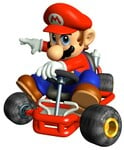 Mario |
Middleweight | 3 ★★★☆☆ |
3 ★★★☆☆ |
3 ★★★☆☆ |
3 ★★★☆☆ |
3 ★★★☆☆ |
3 ★★★☆☆ |
3 ★★★☆☆ |
 Luigi |
Middleweight | 3 ★★★☆☆ |
3 ★★★☆☆ |
3 ★★★☆☆ |
4 ★★★★☆ |
5 ★★★★★ |
5 ★★★★★ |
3 ★★★☆☆ |
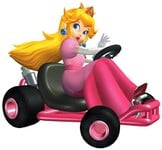 Peach |
Lightweight | 5 ★★★★★ |
1 ★☆☆☆☆ |
2 ★★☆☆☆ |
3 ★★★☆☆ |
4 ★★★★☆ |
2 ★★☆☆☆ |
4 ★★★★☆ |
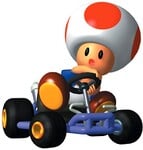 Toad |
Lightweight | 5 ★★★★★ |
1 ★☆☆☆☆ |
2 ★★☆☆☆ |
4 ★★★★☆ |
3 ★★★☆☆ |
3 ★★★☆☆ |
4 ★★★★☆ |
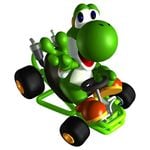 Yoshi |
Lightweight | 4 ★★★★☆ |
2 ★★☆☆☆ |
1 ★☆☆☆☆ |
5 ★★★★★ |
5 ★★★★★ |
3 ★★★☆☆ |
5 ★★★★★ |
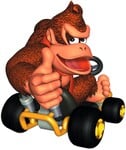 DK |
Heavyweight | 2 ★★☆☆☆ |
4 ★★★★☆ |
4 ★★★★☆ |
2 ★★☆☆☆ |
2 ★★☆☆☆ |
4 ★★★★☆ |
2 ★★☆☆☆ |
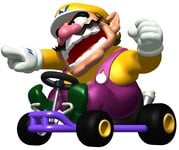 Wario |
Heavyweight | 2 ★★☆☆☆ |
4 ★★★★☆ |
4 ★★★★☆ |
2 ★★☆☆☆ |
1 ★☆☆☆☆ |
1 ★☆☆☆☆ |
2 ★★☆☆☆ |
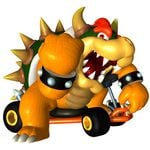 Bowser |
Heavyweight | 1 ★☆☆☆☆ |
5 ★★★★★ |
5 ★★★★★ |
1 ★☆☆☆☆ |
1 ★☆☆☆☆ |
2 ★★☆☆☆ |
1 ★☆☆☆☆ |
Multiplayer only[edit]
| Driver | Description |
|---|---|
Yoshis(new) |
Yoshis in alternate colors are playable in Single-Pak multiplayer, each by a certain player: red for 2, blue for 3, and yellow for 4. They share Yoshi's stats. |
Bob-omb(new) |
Bob-ombs appear in multiplayer battle mode after a player is defeated. They can ram into other players and explode, as well as respawn and collect mushrooms to boost with. They do not appear on the map. |
Rival order[edit]
Similar to Super Mario Kart, a preset order of CPU opponents exists for each character in Grand Prix mode: one very fast, one fast, one medium, one slow, and three very slow drivers. In Quick Run mode, the orders are reversed, except in the first track of each cup. When playing Grand Prix in multiplayer, the rival order depends on the first player's character.
| Player | Rival order | ||||||
|---|---|---|---|---|---|---|---|
| Very fast | Fast | Medium | Slow | Very slow | |||
| Mario | Donkey Kong | Bowser | Luigi | Yoshi | Peach | Toad | Wario |
| Luigi | Wario | Toad | Yoshi | Mario | Peach | Donkey Kong | Bowser |
| Peach | Luigi | Bowser | Donkey Kong | Yoshi | Mario | Toad | Wario |
| Toad | Peach | Luigi | Yoshi | Mario | Wario | Donkey Kong | Bowser |
| Yoshi | Peach | Luigi | Toad | Mario | Wario | Donkey Kong | Bowser |
| Donkey Kong | Yoshi | Bowser | Toad | Luigi | Peach | Mario | Wario |
| Wario | Bowser | Donkey Kong | Yoshi | Mario | Luigi | Peach | Toad |
| Bowser | Donkey Kong | Peach | Mario | Yoshi | Toad | Luigi | Wario |
Courses[edit]
The game features 20 new courses, and brings back the original 20 courses of Super Mario Kart (though, due to the Grand Prix format, they are organized in five cups instead of four). The cups containing Super Mario Kart courses are unlocked for usage in Grand Prix Mode by finishing the respective engine class in first place, and then completing each cup again, while collecting at least 100 coins.
Mario Kart: Super Circuit has the most Bowser Castles (four from this game's tracks and three from the original's tracks, making seven total tracks) in any Mario Kart game to date.
Super Circuit tracks[edit]
These race courses are new and they have three laps, similar to Mario Kart 64 (with Lakitu appearing on the right side of the player, holding the start signal and the lap count signs).
Extra tracks[edit]
These courses were originally featured in Super Mario Kart, and are reused in Mario Kart: Super Circuit. The player races five laps on these tracks (similar to the first game) in Grand Prix mode. These courses lack most of their obstacles from Super Mario Kart (besides the breaking blocks in the Ghost Valley and Vanilla Lake courses and the deep water in the Koopa Beaches). Coin locations are also changed so that each track has exactly 50 coins.
Battle courses[edit]
Four new battle courses appear in the game. No battle courses from the previous Mario Kart games return; however, all four of the courses from Super Mario Kart exist in the game's code and are playable through hacking. The second battle course has a different layout between the Japanese and international versions of the game.
Course elements[edit]
Many other characters are not playable. Some can help out, such as Lakitu, who can pull characters out of the water, and Boo, who serves as an item. Other characters are mainly there to serve as obstacles to racers, and many hinder the racers by making them spin out.
Enemies, obstacles, and species[edit]
| Name | Course appearance(s) | Description |
|---|---|---|
Boo |
Broken Pier | A round white ghost that will circle around any driver stealing their Coins if approached. |
Falling Star |
Rainbow Road | A yellow star with a smiley face that falls on the track, spinning out drivers who hit them. |
Lava Boulder |
Lakeside Park | Molten rocks shot by volcanoes onto the track. Any drivers are burned if they run into it. |
Lava Bubble |
Bowser Castle 1 Bowser Castle 2 Bowser Castle 3 Bowser Castle 4 |
Living fireballs that emerge from lava in the Bowser Castle racetracks. Any drivers are burned if they run into it. |
Mechakoopa |
Bowser Castle 4 | A wind-up toy resembling Bowser. It, walks back and forth on a line, spinning out any drivers that run into it. |
Mice |
Cheese Land | Small mice wearing thief masks. Any driver that collides with them will spin out. |
Penguin |
Snow Land | A light blue penguin that sits on the ground, spinning. Any driver that collides with them will spin out. |
Piranha Plant |
Yoshi Desert | A red and white carnivorous plant that appears in quicksand pits. If a racer falls into one of these pits, they will get pulled under, followed by the Piranha Plant chewing them repeatedly before spitting them out. |
Shy Guy |
Sunset Wilds | A mysterious enemy wearing red robes and a white mask who hides inside a tent. If their tents are hit, they latch onto the driver, causing them to lose coins. Shy Guys in the Japanese version of the game wear Native American war bonnets. |
Shy Guy Galleon |
Shy Guy Beach | A pirate ship with Shy Guys that launches explosive cannonballs onto the course. |
Shy Guy Tent |
Sunset Wilds | A tent hiding a Shy Guy. Hitting the causes the Shy Guy to jump on the driver. |
Sidestepper |
Shy Guy Beach Cheep-Cheep Island |
A crab that marches back and forth across the track. Any driver that collides with them will spin out. |
Snowman |
Snow Land | A snowman wearing a red beanie and a red and white scarf. It can be destroyed by running into them, which stops the driver. |
Thunder Cloud |
Rainbow Road | A cloud that floats above the track, occasionally creating lightning strikes that shrink any racer that passes under them. |
 Thwomp |
Bowser Castle 1 Bowser Castle 2 Bowser Castle 3 Bowser Castle 4 |
Living stone creatures that repeatedly attempt to crush drivers by dropping on them from above. Some Thwomps in Bowser Castle 4 also move from side to side on the air before slamming on the ground. |
Totem pole |
Sunset Wilds | Totem poles that depict a Toady at the bottom, a Snifit in the middle and a Shy Guy at the top. Hitting one slows down the driver. |
Background characters and objects[edit]
Luigi's Blimp in Luigi Circuit and Sky Garden
Little Birds in Cheep-Cheep Island
A Cheep-Cheep during the awards ceremony
A Koopa Paratroopa during the awards ceremony
A Hammer Bro during the awards ceremony
Goombas, Toads, Koopa Troopas, Shy Guys during the awards ceremony
Items[edit]
Mario Kart: Super Circuit features eleven of the fourteen items from Mario Kart 64, with no new additions, also making this and Mario Kart Live: Home Circuit the only Mario Kart games to not introduce any items. Like the past games, items are found in Item Boxes and are typically used to hinder opponents and assist players who obtain them.
| Sprite | Item | Description |
|---|---|---|

|
Mushroom | Obtained commonly by any-ranked drivers, using it grants the driver a great burst of speed within a moment. They can be used to go off-road more easily, and fly further after going over a ramp. They can also be used to bump drivers out of the way; those with no Coins will spin out instead. |

|
Triple Mushrooms | Obtained exclusively in Time Trial and Versus modes. Drivers will have three Mushrooms instead of one. They cannot be replenished once they are all used until the Time Trial or Versus match is over. |

|
Banana | Obtained commonly by high-ranked drivers, they can be held on the back or thrown forward or dropped behind. They act as obstacles; drivers running over them will spin. The effect can nullified if the driver brakes upon running over it; success of the action is indicated by a music note symbol coming out from the driver. Any type of Shell or Star effects can destroy them. |

|
Green Shell | Obtained commonly by high-ranked drivers, they can be held on the back or thrown forward or backward. Once thrown, they can bounce off walls multiple times before breaking; drivers hit by this will spin. Bananas, any type of Shells, or Star effects can destroy them. |

|
Triple Green Shells | Obtained uncommonly by higher-ranked drivers, three Green Shells revolve around the driver, shielding from most attacks. They act like Green Shells, but cannot be thrown backward. |

|
Red Shell | Obtained uncommonly by any-ranked drivers, they can be held on the back or thrown forward or backward. If thrown forward, it will target the next high-ranked driver. If not, it will shoot straight instead and break upon hitting a single wall. If thrown backwards, they stay in a fixed position; if a driver goes near one, it will target them regardless of ranking. Bananas, any type of Shells, or Star effects can destroy them. |

|
Triple Red Shells | Obtained uncommonly by lower-ranked drivers, three Red Shells revolve around the driver, shielding from most attacks. They act like Red Shells, but cannot be thrown backward in a fixed position to target a driver regardless of ranking. |

|
Spiny Shell | Obtained rarely by low-ranked drivers, with rarity determined by engine class, they can be held on the back or thrown forward or backward. It makes a continuously loud noise when used. If thrown forward, it will follow the track and targets the first-place driver; subsequent drivers caught in the path will spin out. If thrown backward, they stay in a fixed position to target the first-place driver passing by. Colliding with a wall or a ramp, falling into a pit or water, or hitting a driver with the star in effect can destroy them. |

|
Boo | Obtained uncommonly by any-ranked drivers, they steal an item from a random driver if available, attacks the first-place driver, and grants invisibility for a moment. The driver is immune to all obstacles and items, and can pass through drivers without bumping, but it doesn't prevent them from losing speed off-road. |

|
Star | Obtained rarely by low-ranked drivers, they grant invincibility and increase their top speed, acceleration, and handling for a moment. Bumping a driver under this effect will spin them out. They are also used to go off-road without losing any speed and can destroy stage obstacles. |

|
Lightning | Obtained rarely by lower-ranked drivers, they shrink every other driver not using a Star or a Boo but does not make them lose coins. Shrunk drivers lose speed and the ability to use a Mushroom. Shrunk drivers run over by a normal driver will spin out. Shrunk drivers revert back to normal after a set amount of time or if they fall into a pit. |
Item probabilities[edit]
The following item chart comes from the Mario Kart Advance Saisoku Butchigiri Guide, released in Japan in 2001.[8] The probability to obtain a certain item goes from A (frequently obtained item) to D (unobtainable item).
| Position | ||||||||||
|---|---|---|---|---|---|---|---|---|---|---|
| 1 | A | C | C | D | D | A | C | D | C | D |
| 2 | D | B | B | C | D | D | B | C | C | D |
| 3 | D | C | A | C | C | D | B | B | C | C |
| 4 | D | C | A | B | C | D | C | B | C | C |
| 5 | D | D | B | B | C | D | C | B | C | C |
| 6 | D | D | B | B | C | D | C | B | C | B |
| 7 | D | D | C | B | B | D | C | C | C | B |
| 8 | D | D | C | B | B | D | C | C | C | B |
Staff[edit]
- Main article: List of Mario Kart: Super Circuit staff
Mario Kart: Super Circuit was developed by Intelligent Systems, the same company behind the Paper Mario series and the WarioWare series. Takeshi Ando and Yukio Morimoto directed the game while the executive producer was Hiroshi Yamauchi. The Donkey Kong 3D model used in the pre-rendered sprites was provided by Rare.
Pre-release and unused content[edit]
Early Nintendo Power screenshots showed that the characters had different, "super-deformed" sprites of bigger heads contrasted by smaller karts. The game was planned to feature all 14 of the Mario Kart 64 items, but the Banana Bunch, Super Mushroom, and Fake Item Box were removed for unknown reasons. The unfinished versions can be seen by using a GameShark code: the Banana Bunch is non-functional, the Super Mushroom acts like normal, and the Fake Item Box causes racers to spin out of control as with a Banana. There is also an infinite version of the Super Mushroom.
Glitches[edit]
CPU Glitch[edit]
To perform this glitch, the player must select the Rainbow Road track with any character in 100cc or 150cc. When the race starts, the player must obtain a banana. At the shortcut area, the player must place the banana on the very corner of the curb leading to the shortcut. After that, the player must drive backward until the player is between the shortcut and the other side, then park on the middle of the track. If a CPU hits the player, the CPU may hit the banana and fall off. When the CPU is put back on track, it will drive toward the shortcut but still falling.[9]
Koopa Beach 1 Glitch Shortcut[edit]
If the player spindrifts after the finish line then aims behind it correctly, that player can perform a glitch were it could count as a lap if they shroomed behind the finish line with a hop.[10]
Cheese Land Glitch Shortcut[edit]
If the player spindrifts 270° right going behind the starting line, that player could perform a glitch where the player can use a mushroom and a hop onto Little Mouser to count all three laps if successful. This will work with any character.[11]
Reception[edit]
Critical reception[edit]
Mario Kart: Super Circuit received critical acclaim. It scored an average of 91.54% based on 39 reviews in GameRankings and an average of 93 based on 24 reviews in Metacritic.[12][13]
Craig Harris of IGN praised nearly all of the game's aspects and noted that the extra development time of the game can make it outstanding. He ended with, "It's a GBA game with very few flaws -- it's a shame that it didn't quite make the system launch, but the extra wait did the game wonders, and it shouldn't be missed." He gave the game a 9.5 out of 10.[2] Tom Bramwell of Eurogamer gave the game a 9 out of 10. Though he criticized the lack of backlighting due to the Game Boy Advance system lacking it and the pick-up system of Lakitu, he praised the game for being a vast, improved "conversion" of Super Mario Kart onto the Game Boy Advance. He wrote, "It has everything a single player, or indeed a foursome of like-minded console gamers, could ever dream of, and all with the added benefit of extensive replayability. With Super Mario Advance 2 still a way off, Mario Kart Super Circuit is the killer app for GameBoy Advance as of now. Buy it."[14] Joao Diniz Sanches of Pocket Gamer UK gave the game a 9 out of 10. He praised the game for being universally and immediately fun.[15]
Ron DelVillano of Nintendo Life reviewed the ambassador version of Mario Kart: Super Circuit and gave the game a 7 out of 10. Though he noted the game's aging and that the multiplayer is removed in the 3DS Ambassador version, he called the game fun and worthwhile to play with.[16]
| Reviews | |||
|---|---|---|---|
| Release | Reviewer, Publication | Score | Comment |
| Game Boy Advance | Craig Harris, IGN | 9.5/10 | "Mario Kart Super Circuit is a perfect example of how a little extra development time can do a Game Boy Advance title wonders." |
| Game Boy Advance | Tom Bramwell, Eurogamer | 9/10 | "Mario Kart Super Circuit is the killer app for GameBoy Advance as of now. Buy it." |
| Game Boy Advance | Joao Diniz Sanches, Pocket Gamer UK | 9/10 | "There is obviously scope for bettering your skills both as driver and combatant, and the sense of achievement from outplaying the competition is immense, but ultimately Super Circuit's greatest achievement has to be how immediately and universally the game's exceptional thrills can be enjoyed." |
| Nintendo 3DS | Ron DelVillano, Nintendo Life | 7/10 | "It may not have aged as well as some other classic games, Mario Kart: Super Circuit is still a good time and provides hours of kart racing action to anyone looking for it." |
| Game Boy Advance | Amer Ajami, GameSpot | 8.2/10 | "Whether you're an ardent fan of the Mario Kart series or a first-time player, Mario Kart Super Circuit is a must-have for owners of the Game Boy Advance." |
| Game Boy Advance | Mark Brown, Cubed3 | 9/10 | "Some may try to tell you otherwise, but this is the definitive version of Mario Kart, and a perfect way to warm up your karting skills in the run-up to the GameCube's forthcoming release. Thoroughly recommended." |
| Aggregators | |||
| Compiler | Platform / Score | ||
| Metacritic | 93 | ||
| GameRankings | 91.54% | ||
Sales[edit]
Mario Kart: Super Circuit is the fourth best-selling game for the Game Boy Advance after Pokémon Ruby, Sapphire, FireRed, LeafGreen, and Emerald, selling 5.91 million copies worldwide, as of March 31, 2009.
Gallery[edit]
- For this subject's image gallery, see Gallery:Mario Kart: Super Circuit.
Mario and Bowser
Lakitu and the playable characters
Wario and Toad racing on Yoshi Desert.
Donkey Kong, Toad, and Mario racing on Shy Guy Beach.
Multimedia[edit]
- For the complete list of media files for this subject, see Multimedia:Mario Kart: Super Circuit.
| File info 0:30 |
| File info 0:30 |
| File info 0:18 |
| File info 1:26 |
References to other games[edit]
- All race courses from this game return, albeit with the hazards removed.
- Coins return in Mario Kart: Super Circuit with the same use as in this game, though without the Coin item.
- Part of the music used for Boo Lake/Broken Pier and the Mario Kart: Super Circuit Rainbow Road is an arrangement of the music from the Ghost Valley and Rainbow Road courses, respectively.
- The music used for the title screen, main menu, and Mario's results screen are arranged as music used for Single Game Pak multiplayer.
- The theme for the Bowser Castle courses has a similar bassline to "Bowser's Theme" from this game.
- Many sprites and artwork in this game are based off the sprites in this game, such as the karts, characters, and the character selection screen portraits.
- Most of the items from this game return.
- Players who lose in battle mode in Mario Kart: Super Circuit turn into Bob-ombs, similar to turning into Mini Bomb Karts.
- The selection of playable characters is the same as in this game.
- Cheep Cheeps use the design of Blurps from this game.
- Shy Guy Beach is based on the level Shy Guy's Ship from this game.
- Princess Peach's Castle appears in the background of Peach Circuit.
- Bowser's Castle along with Princess Peach's Castle on top of it appears in the background of Rainbow Road.
- The Hammer Bros. and Goombas seen during the awards ceremony have the same appearance as in this game.
References in later games[edit]
- The association between blue sparks and Mini-Turbos returns.
- The horn sounds of Mario, Toad, and Yoshi’s karts return for three of the karts in this game; Mario’s horn sound is used for the Red Fire, Toad’s horn sound is used for the Toad Kart, and Yoshi’s horn sound is used for the Goo-Goo Buggy.
- Lightning Cup returns as part of the Gimmick Masters section of this game's tournament mode. However, the said cup goes by the name "Thunder Cup" in that game's English or Japanese version, as the Lightning Cup has been usually called the Thunder Cup in Japanese sources and not English ones.
- This game uses the ranking system of Mario Kart: Super Circuit.
- Four tracks return in this game: Peach Circuit, Bowser Castle 2, Luigi Circuit, and Sky Garden.
- The Lightning Cup has been traditionally modified as one of the four retro cups, and Sky Garden appears in the Lightning Cup in both of the games, a first and only time for the series.
- The Quick Run concept has been reused and renamed as Vs. Mode.
- The idea of returning race courses originates from Mario Kart: Super Circuit.
- Shy Guy Beach, Bowser Castle 3, and Battle Course 3 return in this game.
- Bowser Castle 1 and Battle Course 1 return in this game.
- One of the songs is a medley of the Rainbow Road themes from Mario Kart: Super Circuit, Mario Kart DS, and Mario Kart 7.
- Mario Circuit returns as a retro course in this game and now features anti-gravity on the U-shaped section that has been inclined.
- Cheese Land and Ribbon Road return in Mario Kart 8 as retro courses in the second DLC pack, and come standard in Mario Kart 8 Deluxe.
- Sky Garden, Snow Land, Boo Lake, Riverside Park, and Sunset Wilds are included among the courses in the Booster Course Pass for Mario Kart 8 Deluxe.
- Peach Circuit, Riverside Park, Bowser Castle 1, Boo Lake, Bowser Castle 2, Luigi Circuit, Sky Garden, Cheep-Cheep Island, Sunset Wilds, Snow Land, Yoshi Desert, Bowser Castle 3, and Bowser Castle 4 appear as returning race courses.
- Battle Course 1 appears as a returning battle course.
- Arrangements of "Peach Circuit", "Shy Guy Beach", "Riverside Park", "Koopa Castle Course", "Cheese Land", "Ribbon Road", "Yoshi Desert", and "Rainbow Road" can be heard in VS Race routes and/or Free Roam.
Names in other languages[edit]
| Language | Name | Meaning | Notes |
|---|---|---|---|
| Japanese | マリオカートアドバンス[?] Mario Kāto Adobansu |
Mario Kart Advance This is the only Mario Kart game where the English and Japanese titles differ. |
|
| Chinese (Simplified) | 马力欧卡丁车 超级赛道[?] Mǎlì'ōu Kǎdīngchē Chāojí Sàidào |
Mario Kart: Super Circuit | From the unreleased iQue version. |
| 马力欧卡丁车ADVANCE[?] Mǎlì'ōu Kǎdīngchē Advance |
Mario Kart Advance | Game Boy Advance - Nintendo Classics | |
| Chinese (Traditional) | 瑪利歐賽車Advance[17] Mǎlì'ōu Sàichē Advance |
Mario Kart Advance | |
| 瑪利歐賽車ADVANCE[18] Mǎlì'ōu Sàichē Advance |
Notes[edit]
- In Japan, it was once possible to challenge other players online by connecting the Game Boy Advance to a compatible mobile phone via the Mobile Adapter GB. Players could upload personal records, browse national rankings, and participate in Time Trial-based tournaments with real prizes as well.[19] This service ended in December 2002.
- This game was going to make use of the e-Reader at one point according to the European website for the game, but the section of the site intended to provide details on the e-Reader cards consisted of only a "Coming Soon" notice.[citation needed]
- This game was planned to release in mainland China by iQue, but was left unreleased due to the huge scene of piracy in China at that time. The unreleased Chinese prototype received an ISBN, meaning it was approved for distribution despite the ban on video games from the Chinese government. Together with Mario & Luigi: Superstar Saga, this was one of two Super Mario titles to be affected in this manner.[20]
- In multiplayer, player 4's player color is purple in the menus, but is blue in-game.
References[edit]
- ^ マリオカートアドバンス. Nintendo Co., Ltd. (Japanese). Retrieved February 21, 2018.
- ^ a b Harris, Craig (August 29, 2001). Mario Kart Super Circuit. IGN (English). Retrieved November 11, 2024. (Archived April 4, 2004, 13:40:29 UTC via Wayback Machine.)
- ^ Mario Kart Super Circuit (2001) | GBA Game. Nintendo Life (English). Retrieved November 11, 2024.
- ^ Craig Harris (July 27, 2006). Player's Choice, Round Two. IGN (English). Retrieved November 10, 2024.
- ^ Mario Kart: Super Circuit | Game Boy Advance | Games. Nintendo UK (British English). Retrieved November 11, 2024.
- ^ Mario Kart: Super Circuit Chinese ROM information
- ^ FerneuMKSC (October 15, 2017). Mario Kart: Super Circuit – Rank Calculation Guide. GameFAQs. Retrieved May 12, 2023. (Archived May 12, 2023, 22:50:15 UTC via Wayback Machine.)
- ^ @Airship804 (January 12, 2024). Hello and thank you for finding me! Yes, I still have the guidebook and it indeed has a table of the item distribution, although the exact values are not shown. ◎ are the most common items, ○ are moderate, △ are occasional, and × are not obtainable. I hope this helps you! :). X. Retrieved November 11, 2024.
- ^ dockside2012 (July 13, 2009). Mario Kart Super Circuit Glitch. YouTube (English). Retrieved November 11, 2024.[dead link]
- ^ Mario Kart: Super Circuit (September 29, 2013). SNES Koopa Beach 1 (SC): 0'07"66 by Su. YouTube. Retrieved November 11, 2024.
- ^ Glitch Shorts (January 29, 2021). Amazing Way To Cheese The Incredibly Broken Cheese Land - Glitch Shorts (Mario Kart Super Circuit). YouTube (English). Retrieved November 11, 2024.
- ^ Mario Kart: Super Circuit for Game Boy Advance. GameRankings (English). Archived March 19, 2016, 22:08:16 UTC from the original via Wayback Machine. Retrieved November 11, 2024.
- ^ Mario Kart: Super Circuit. Metacritic (English). Retrieved November 11, 2024.
- ^ Bramwell, Tom (September 27, 2001). Mario Kart: Super Circuit review. Eurogamer (English). Retrieved November 11, 2024.
- ^ Sanches, Joao Diniz (October 21, 2005). Mario Kart: Super Circuit review. Pocket Gamer (English). Retrieved November 11, 2024.
- ^ DelVillano, Ron (December 22, 2011). Mario Kart: Super Circuit review. Nintendo Life (English). Retrieved November 11, 2024.
- ^ 瑪利歐歷史|超級瑪利歐兄弟 35週年|任天堂. Nintendo HK (Traditional Chinese). Archived May 16, 2021, 02:03:20 UTC from the original via Wayback Machine. Retrieved November 11, 2024.
- ^ Nintendo (February 9, 2023). Switch Online的最新資訊!「Nintendo Switch Online」的新成員Game Boy及 「Nintendo Switch Online + 擴充包」的新成員Game Boy Advance現已登場。 www.nintendo.com.hk/topics/article/a_230209_09.html. Nintendo HK (Traditional Chinese). Retrieved November 11, 2024.
- ^ モバイルコンテンツ/マリオカートアドバンス モバイルGP. Nintendo (Japanese). Archived December 15, 2002, 13:33:35 UTC from the original via Wayback Machine. Retrieved November 11, 2024.
- ^ Alistair Wong (March 25, 2019). A Look Into What Could’ve Been: Prototype Unreleased Chinese GBA Games. Siliconera (English). Retrieved January 17, 2025. (Archived February 5, 2023, 17:46:00 UTC via Wayback Machine.)
External links[edit]
- Japanese website
- European (UK) microsite
- Japanese commercial
- American commercial (full)
- American commercial (extended)
- American commercial (short)
